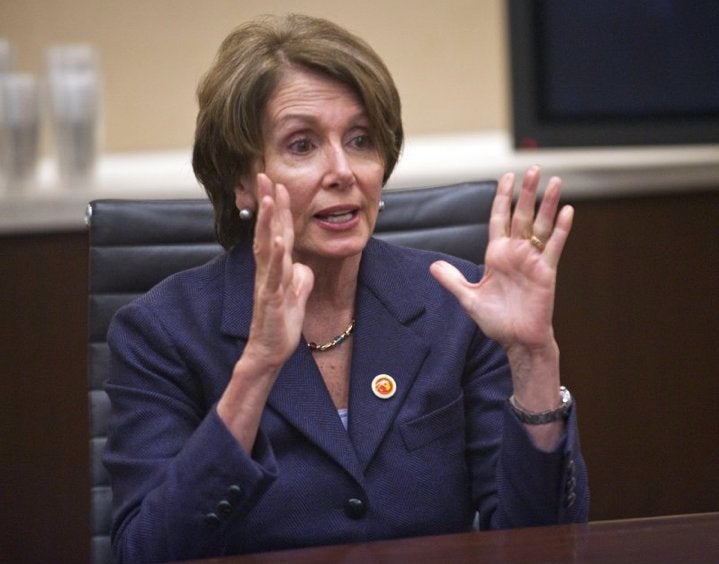
When House Minority Leader Nancy Pelosi met with two dozen women reporters and editors at the Huffington Post late last week, she was considered a role model by many in the room. Here was a woman who'd had five children (in six years!) then went on to hold the highest office ever held by a woman in this country -- Speaker of the House.
But role models often teach unexpected lessons, and while Rep. Pelosi (D-Calif.) was describing "how she does it," her youngest daughter, Alexandra, who had come along on this visit, interrupted.
"She was a stay-at-home-Mom for all those years," she said, wanting to make it clear that her mother had not been raising five children while running the country, or even running for office. In fact, she did not run until Alexandra was almost out of high school.
"Explain that to them," she said.
And so, Pelosi explained. "I don't have any idea of how people have kids and jobs," she confessed. "Some days I just didn't wash my face," she said, when her children were young, and that was without any workplace demands.
Today's women, with all our choices, could not be more grateful to Pelosi's generation, which blazed the trail. And yet, looked at closely, it becomes discomfitingly clear that hers is a path effectively closed by its own success.
There was a moment in time when women could live their lives serially -- have their children during the 1950s and 60s, when not much more than that was expected of them; launch those children by the 70s and 80s, when doors were newly opened to women. Pelosi, now 71, was of that moment. So were Supreme Court Justices Sandra Day O'Connor, 81, and Ruth Bader Ginsburg, 78. Both graduated from law school during the 1950s, then spent years on the slow career track or as a stay-at-home-mother, and came roaring back when their children were older.
That route, however, isn't really open to women any more. If today's young women were to do the same -- have their children young, expect to get started on a career when those children were grown -- they would emerge to closed doors.
Which leaves them facing a different set of options. They can do what Pelosi herself says she could not have imagined doing: raising children and working full-steam-ahead for pay. Or, they can get a running start in the workplace, hoping to build up momentum, then step out or ratchet back for a few years and gamble that they can ramp up again some day.
Or they can just not become mothers at all.
Data show that more are taking that last path. (Among them, the two newest women justices, Sonia Sotomayor and Elena Kagan, neither of whom have children.) According to The Center for Work-Life Policy, a nonprofit that studies workplace issues, 43 percent of women between the ages of 33 and 46 (and 32 percent of men in the same age group) are childless -- the result, a large percentage say, of deliberate choice. They are working too hard, they tell researchers (nearly a third of high-earning Gen Xers work 60+ hours a week), they are too ambitious to stop, and even if they wanted to they really don't see how they could (what with their student loans and credit card debt, and with economists predicting that they will be the first generation not to match their parents' living standards.)
What, then, is the responsibility of government -- of trailblazers like Pelosi -- to help them? A few news items this past week raise some possibilities of top-down action.
First, a Census analysis released the morning of Pelosi's visit found that maternity leave is a victim of the economy, and the less educated the woman the more likely she is to be denied maternity benefits. A stronger Federal policy on parental leave (you know, like most of the rest of the Western world has) would help those who are now effectively choosing between a paycheck and a child.
Better child care options would help, too, Pelosi agreed. "We have to train for it, and pay for it, and have national standards for it," she said of the Federal responsibility toward child care. But a study released last month by the National Women's Law Center finds options closing here, too. As the Center reports, "Families in thirty-seven states are worse off under one or more key child care policies in 2011 than they were in 2010."
So yes, policy and legislation can nudge bits of this problem, but can these truly address the whole? Not likely. Something more is needed, a two-pronged something that would rewrite the equation as completely as the second wave feminists did forty years ago.
First, the workplace has to change. We have to adjust our vision of the "ideal worker" from one who need not pause in either their day or their career path, to one who blends life and work in new and flexible ways. And that change is cultural, not legislated. It is starting to happen, but will only be complete when businesses realize that flexible workers are actually better and more productive workers, and when workers begin to simply "take" flexibility where they can. (I have great faith in Gen Y, here.)
And, at the same time, home must change too. We have to reach the point where the challenge of timing life and work is not just a woman's problem, but rather a family problem, with both sexes pausing and flexing. This too can't be enforced with a vote of Congress. It has to happen one house at a time.
If we can somehow do this, and alter social norms, we might just look back and see a dividing line between the generation that had to choose, from one that has real choice.